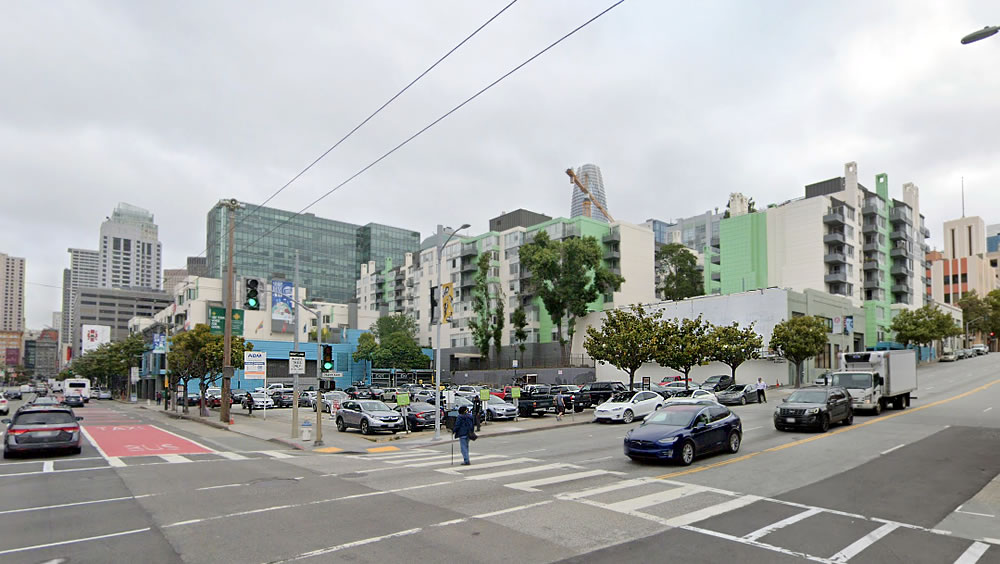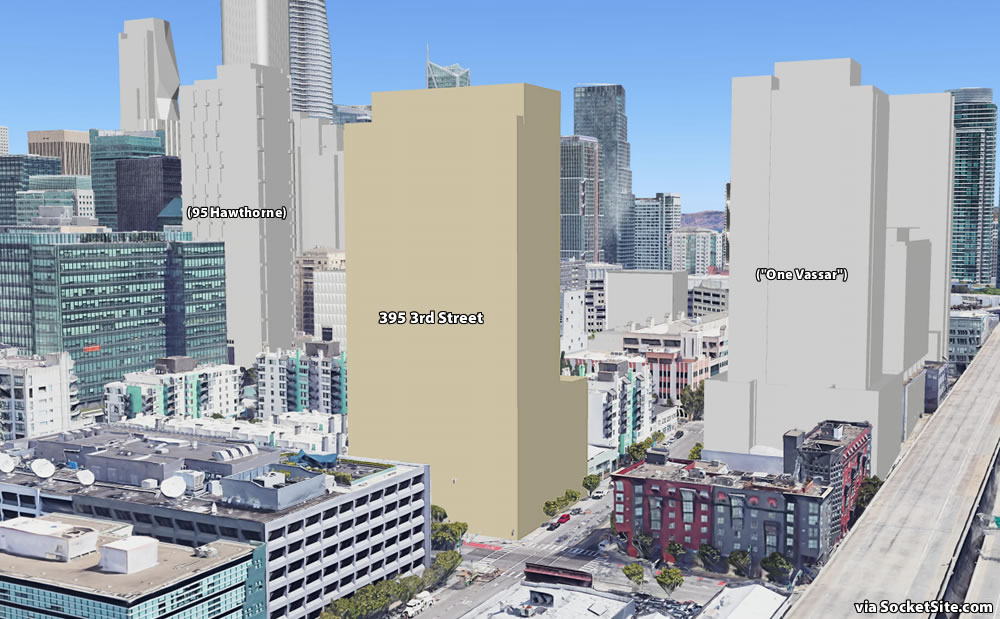Speaking of bonus-based plans for new infill towers to rise, plans for a 35-story tower to rise on the 90-space parking lot parcel at 395 3rd Street, on the northeast corner of 3rd and Harrison, cater-corner to the approved One Vassar development and a block away from the approved tower to rise at 95 Hawthorne Street, are in the works as well.
As envisioned, the tower would rise up to 347 feet in height, with 559 apartments (a mix of 127 studios, 207 one-bedrooms, and 225 twos) over 7,500-square-feet of ground floor retail space and a basement garage for 140 cars.
And as the Central SoMa parcel is currently only zoned for development up to 200 feet in height, having already been up-zoned from 85 feet in height by way of the Central SoMa Plan, the Strada Group is planning to seek a State Density Bonus for the additional height (along with a waiver from the existing open space requirements for the site).
We’ll keep you posted and plugged-in.


Awesome! We love to see parking lots turn into hundreds of homes.
The state density bonus is such a win for California. I hope it will be expanded / strengthened in the coming years.
I see the future of San Francisco to be multiple high rises in the suburbs: Sunset, Richmond neighborhoods. Single family dwellings just won’t make it where land is scarce.
Isn’t the issue, desirability? It would be many decades before all other locations in the city are so full that high rises would be build in the Sunset. Maybe up to Seventh and Irving, but beyond that, I don’t see that. It’s cold, windy and depressingly dark for months at a time.
Well that hasn’t stopped similar buildings from going up in Portland, Seattle, and Vancouver. And given some of the planned buildings for Parkmerced and the proposal for Stonestown (should even a portion of them come to fruition), I don’t think demand is really the issue.
The larger issue is demand. Thee are about 61k units in the pipeline. SF’s population is falling – it’s only a question of how much. 862k could well turn out to be the historic peak population – though some claim it hit 900k at the end of the Second World War. As it is, all of the 61k units will probably not be needed in a post-pandemic reality.
This project as well as the one featured yesterday are entitlement plays. The developer can potentially hold onto the rights for a decade at little cost (once granted) and in the meantime move their investment dollars to markets seeing a lot of current construction like Austin and Seattle.
Circling back, I don’t believe a situation will arise where there is such a demand for additional housing that hi-rises will be built in the Sunset or Richmond.
> As it is, all of the 61k units will probably not be needed in a post-pandemic reality.
If you’re trying to predict the end of San Francisco’s growth history is not on your side. The boom and bust cycle is just a force of nature at this point, and each cycle always results in greater population even after the bust. The only true exodus SF ever saw long term was back when Americans were moving out of cities and into newly constructed suburbs. That will never happen again both due to changing attitudes in our culture toward urban life, and for the fact that we’ve already developed the land surrounding cities and cheap suburban growth like that is now impossible. Obviously, your predictions for the future are your own opinion, but betting that San Francisco will settle onto its 1950 population permanently is kinda ridiculous.
Where and how we work is undergoing an historic transformation which won’t reverse. The pandemic accelerated this – a change that was already seeing a dispersal of especially tech jobs among a number of hubs. Many being in medium sized areas like Boise or Colorado Springs. Ironically the exodus to the suburbs that you mention not happening ever again is happening again. Only this time the exodus is not just to the suburbs but also to the exurbs adding a new twist to the mix. Companies can locate a hub on the fringe of the Bay Area and that makes commutes on a 3/2 schedule very doable from Sacramento. Santa Rosa and the surrounding pristine area also becomes a doable commute on a 3/2.
The University of Southern California just released a survey of those permanently teleworking during Covid. Only 18% wanted to go back to 5 days/week in the office. The large majority wanted to go to 3/2 or 2/3 partial telework. That could drop the need for office space in a city like SF by companies with offices there by 40% or so. On top of all the companies leaving the City altogether. The new paradigm implies a change in housing – larger homes with home offices and fitness rooms (likely to become a new fad). SF mostly does not offer the type of residential stock that will be most in demand.
Who knows if SF settles into its 1950 population. My guess is a range of 700k -750. Even if your job is in SF but you are given the chance to telework 3 days a week and now live in the Sunset, you will be tempted to move to oh, I dunno, Petaluma? A beautiful town with a quaint downtown, excellent restaurants and good schools. Or if you don’t want to do the bridge then Burlingame which is a gorgeous town.
Things won’t return to normal as there is an emerging new normal.
If I has a nickel for every survey whose predictions came to naught, I’d have $653,112 dollars in the bank; oh wait…
I think you’re half right: it’s wise to focus on population… but not resident population: it’s the population of workers that’s matters. SF would suffer little if the former drops to 1950 levels, since residents demand services, which cost money. It’s the cash-flow positive army of employees, owners, partners, etc. that would be a KO if they left. SF having a big population but a trivial office sector would turn it into ..well, a bigger Oakland.
And how lovely will Petaluma be once they start paving over all the vineyards for the McMansions of the tech workers moving out of SF (with fitness rooms, naturally)?
I mean, it wouldn’t shock me if wealthy remote-workers moved out. What’s the result? Rents will fall and the people who make the city actually function might be able to move in? Horrors.
I feel like Dave’s analysis, like a lot of these, focuses exclusively on the top 10%, and treats their experience like the only one that matters. If a bunch of people pack up and leave their chic condos for rural chateaus en masse, there will be plenty of people happy to take their place– at the new, lower price.
I’d add that one of the big drivers of demographic change over the last century has been the fall in household sizes. When SF’s population last peaked, it had far less housing. As families shrank and people became wealthier, fewer people used more space, and now it’s “reasonable” for a family of four to live in a 4000 square foot house. If wealthier workers move out, and leave these spaces, it might even lead to an increase in population, since they’ll be used by extended families and roommates.
Dave (Seattle dude) makes it sound like the only reason anyone would live in SF is to work at a tech job downtown. SF has a history with many different chapters. It seems like the overall consensus is the worst period for all residents was 2010-2020. So why would we want to bring that back? Sure, some people will move. But it’s not everyone’s dream to move to Burlingame or Petaluma. Why pay $3MM to live in Burlingame when you can become a remote worker and live in another state? SF at least provides a “unique” experience. Burlingame is no different than hundreds of cities around the country. In fact, the only value prop for the peninsula is proximity to tech jobs.
Forgot to add that the latest Zumper rent report shows that Mt View, Menlo Park, Redwood City, Santa Clara, and Sunnyvale all saw bigger rent decreases year-over-year than SF.
Well, this is a real estate site, after all. If housing costs aren’t growing 10% a year, it’s a bad thing, and if they actually fall a significant amount (!) and stay there for a few years (!!), it’s an utter catastrophe. For speculators, anyway. They’re off looking for the next hype… Apparently Burlingame or Petaluma? Ok, good luck to them.
Meanwhile, life goes on. Even for developers, who are planning their next projects.
Except that the last US Census population estimate was 881,549. Look it up, henny.
That was pre-pandemic. Wait for the next one.
I don’t understand what you get out of always coming onto a San Francisco page and talk about how things aren’t going to work out. San Francisco will most definitely bounce back. Seattle is still behind SF in population, number of skyscrapers, worse homeless population, and also has residents leaving. Please stop being so negative about the bounce back of San Francisco. All your assumptions are not true.
Exactly. Doesn’t even need to be high-rise, just 8-story wood buildings scattered throughout the west side would be great.
The Richmond and Sunset district are not suburbs,. They are neighborhoods in the city of SF. Yes they need more density, but if you want to talk about suburbs, why not talk about actual suburbs?
650 Harrison Street is right there too. That’s exciting. More buildings to block shield the back of Jasper.
I’m heartened to know someone else finds the back of the Jasper so fugly.
Yes, one of the uglier ones around (and there are plenty). Hard for me to believe that someone drew a picture of that and then someone said “Yes! That’s awesome. Let’s build that.”
And, in addition to the tower on Hawthorne, there are the residential proposals for 655 Folsom (Canton Seafood building) and 667 Folsom (“wrap-around” project) at that same intersection.
While I disagree with Seattle Dude’s pessimism, I totally agree that these are entitlement plays that the current developers will sell off in the next cycle. (Which hopefully arrives soon!)
While these may be entitlement plays, it’s good that we’re building the pipeline for when these projects do pencil out. Demand will return…it’s just a matter of when. After the 2007-2008 crash, all of the entitled projects on Rincon Hill were sold and then built in the next cycle. (Who else remembers when the first tower of Rincon Hill sat by itself on the edge of downtown?!?) The same will happen for many of these projects throughout SoMa and Mid-Market.
More high density next to a freeway in the area with the city’s most polluted air and highest liquefaction risk. Meanwhile, a house in the Sunset can’t even be subdivided into a fourplex. We have got to get rid of the low-density zoning in affluent areas, zoning laws that San Franciscans never voted on and most don’t support.